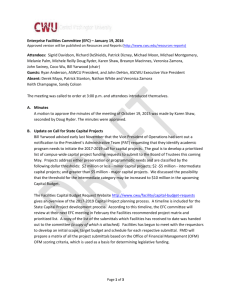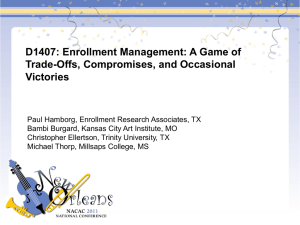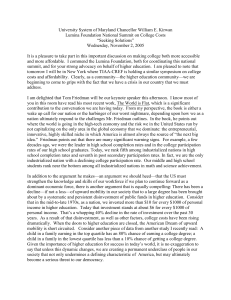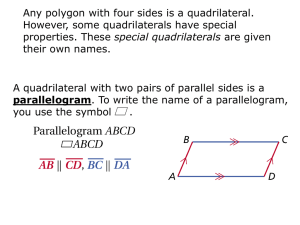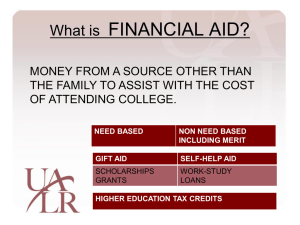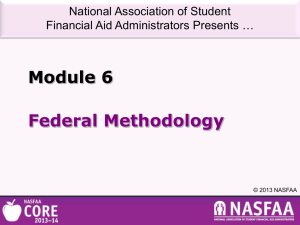EFC Reference Table: College Financial Aid Estimator
advertisement
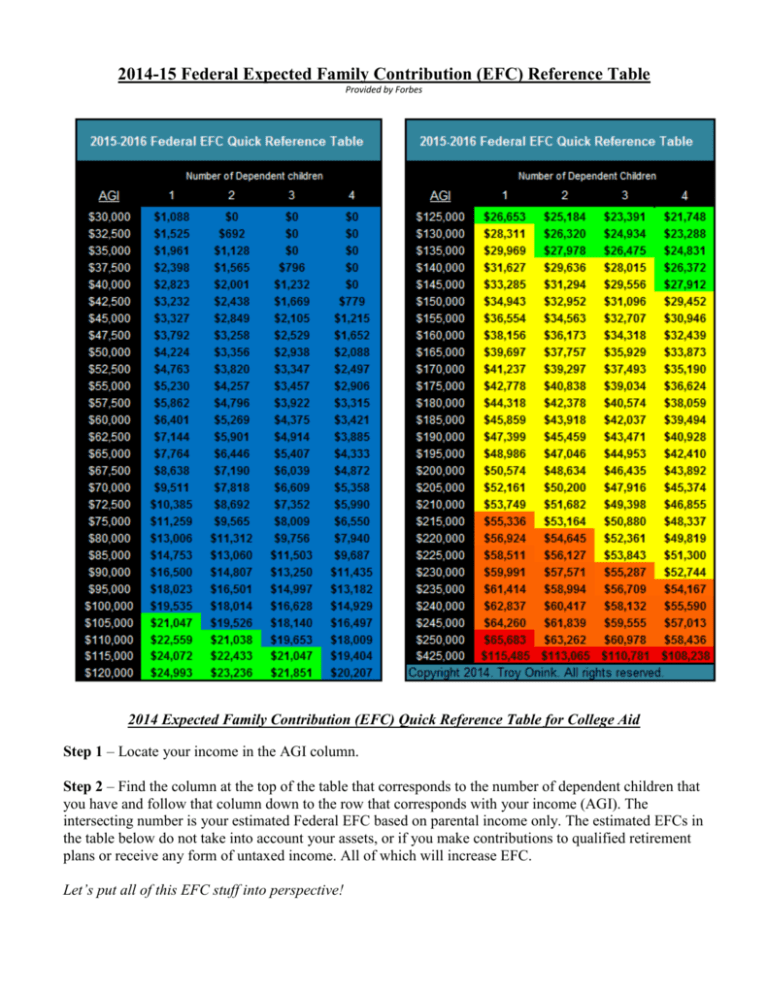
2014-15 Federal Expected Family Contribution (EFC) Reference Table Provided by Forbes 2014 Expected Family Contribution (EFC) Quick Reference Table for College Aid Step 1 – Locate your income in the AGI column. Step 2 – Find the column at the top of the table that corresponds to the number of dependent children that you have and follow that column down to the row that corresponds with your income (AGI). The intersecting number is your estimated Federal EFC based on parental income only. The estimated EFCs in the table below do not take into account your assets, or if you make contributions to qualified retirement plans or receive any form of untaxed income. All of which will increase EFC. Let’s put all of this EFC stuff into perspective! Color Codes All of the EFCs are color coded to give you an idea of whether the student will qualify for need-based financial aid at four categories of colleges. The color coded EFCs in the table are based on national average costs and your income only. If your (income-only) EFC is BLUE – then your child should qualify for need-based aid at two-year public colleges; GREEN – would qualify at four-year public colleges (in-state tuition); YELLOW – would qualify at average four-year private colleges; ORANGE – would qualify at four-year elite private colleges, such as the Ivy League colleges and other highly selective and well-known universities; RED – would not qualify for need-based aid at any colleges or universities. How Assets Are Counted On College Aid Forms The EFCs in the table do not take into consideration any parent or student assets that may be reportable on the financial aid forms, and counted in the aid formulas. The intent of this table is to give you a simplified quick reference to EFC. In general, the assets that get counted are non-retirement assets, and the aid formulas weigh assets in students names more heavily (20-25%) than they do parents’ assets (5-5.64%), except under the Consensus Methodology which treats both student and parent assets at 5%. Small business assets do not count under the Federal Methodology, but they do under the Institutional and Consensus Methodologies. Likewise, home equity counts under the Institutional Methodology, but only up to 1.2 times the parent’s adjusted gross income (AGI) under the Consensus, and not at all under the Federal Methodology. Therefore, when your assets are added into the overall aid calculation your actual EFC may be higher. Furthermore, the average cost of college in your home state may vary from the national average costs that this table uses to estimate aid eligibility, and the EFCs shown are based solely on the Federal Methodology of calculating EFC. Your Child Qualifies for Need-Based Financial Aid Using the example from above, if your income is $70,000 and you have two dependent children, your EFC is $7,549 and is blue, which means that based on this estimated EFC using your income alone (your actual EFC may be higher), your child should qualify for need-based financial aid at all three types of colleges. As a result, your child is eligible to receive need-based grants, scholarships, work-study and student loans as part of the child’s financial aid package. Eligibility does not mean certainty however. You will have to wait to see what form of aid the child gets and how much it is worth. Remember, this EFC estimate is based on your income alone. Some types of assets are counted in the aid formula in addition to your income. Your Child Doesn’t Qualify for Need-Based Financial Aid On the other hand, if your income is $250,000 and you have one dependent child, then your EFC is $69,288 and is red, which means that your child won’t likely qualify for need-based aid at any of the four types of schools used (Two-year public, four-year public, four-year private and four-year elite private colleges). But, that doesn’t mean that you have to pay $69,288 per year because the “sticker prices” are less than that. You will never pay more than the cost of attendance. Keep in mind too that the costs used to create the table are national average costs for these types of colleges and that the cost of attendance of a specific college will be different than the national average. The Ivy League colleges and most of the elite private colleges are as much $62,000 annually, but the 2013-2014 national average cost for 4 year private colleges is $50,000. EFC With Two Kids in College at the Same Time Note that under both formulas, if parents have two children in college, the parent’s portion of the expected family contribution is not twice what it would be for one child. In fact, in the federal formula, the parent’s portion of the family contribution gets split equally (50/50) among the number of students in college. So if the parent’s have one child in college and have an earned income of $140,000, their EFC will be about $33,000 per year for that child. With two children in college, the parent’s EFC will get split 50/50 and applied to each child’s overall EFC, or $16,500 each. Bottom line: If you have more than one child attending a pricey private college, you may qualify for need-based aid even at a fairly high income level. Eligible For Aid at One College, But Not at Another A student’s eligibility for need-based aid is relative to the cost of attendance of each college the student is considering. The student may qualify for need-based aid at one college and not at another. Using the example above, based solely on the parent’s income alone, and forgetting all assets for the moment, parents earning $140,000 per year in income would have an EFC of approximately $33,000 per year under the federal formula with one child in college. At the private college costing $62,000 per year, the student would qualify for $29,000 per year in need-based student aid because the student’s EFC is $29,000 less than the college’s cost of attendance. Conversely, at the state university costing $24,000 per year, the student wouldn’t qualify for any need-based student aid because the student’s EFC is higher than the cost of attendance. The Financial Aid Award For the most part however, even if a student qualifies for need-based aid it doesn’t mean that the college or university will meet 100% of the student’s need. And in most cases you won’t know what the student’s “aid package” will consist of until the student receives his/her financial aid award letter. Don’t get too caught up in trying to predict the exact makeup of a student’s aid package based on a bunch of statistics pertaining to the college’s historical aid awards. Rather, try to get an idea of what amount of aid the student is eligible for and focus on the most useful statistic, percentage of need met. Percentage of need met is a statistic that the majority of colleges release annually, and represents the average percentage of need that the college met for students that had need-based aid eligibility in the previous year’s incoming freshman class. For example, on average one college might only meet 70% of student’s need, and another college (like many of the elite private colleges) might meet 100% of need. That’s a very big difference in aid, especially over four years. The percentage of need met reflects all of the aid packaged by the college’s aid office on behalf of the students, including federal aid, state aid, and private scholarships and so on. Thus, it reflects all forms of aid, including merit aid, in one statistic. How College Selection Impacts Financial Aid The next thing you can do with the percentage of need met is to apply the rule of thumb that if the student, from and admissions perspective, is a good candidate for admission, or the college wants the student for a particular reason (whatever that may be), the student is more likely to get an aid package that meets a higher percentage of need met than the published average, and might expect that aid package to contain more grants and scholarships than student loans and work-study, especially at private colleges where they have greater flexibility to discount their tuition (i.e. knock something off the sticker price). If the student is a possible, reach or far reach candidate for admissions (i.e. the college isn’t all that interested in the student), the student might get admitted, but getting an optimal aid package might also be a far reach. This is a clear example of how college selection and affordability are integrated, and the reason why knowing what EFC formula and aid forms a college requires is also critical. For example, a state university will most likely require only the FAFSA to be completed, and as noted above, the FAFSA information goes into the Federal Methodology formula for calculating the student’s EFC. An elite private college will require the FAFSA to be completed to determine the student’s eligibility for federal student aid, likely state aid too, but will require the student to also complete the CSS Profile to determine the student’s need (eligibility) for its own institutional aid dollars. And since the two formulas calculate EFC differently, have different provisions for some circumstances and in the case of the CSS Profile, may also require financial information from non-custodial parents as well as the parent with whom the child resides (if divorced or separated), the student’s aid eligibility could be much lower at one college versus another on the basis of what aid form and formula a college uses. Moreover, as you will read about below, merit aid is another form of financial aid, but merit aid awards are not based on the student’s EFC (family finances), it is based on the merits of the student. Some colleges offer academic merit aid and others do not. Got a smart kid who has the grades, he might be able to get the aid, but not at all colleges. Merit Aid Merit aid is another form of student aid that is based on the student’s academic, athletic, music and other merits, not family finances. Therefore, any student can receive merit aid. The best things about merit aid are 1) merit awards are typically grants, scholarships or tuition discounts that don’t need to be repaid, unlike student loans and 2) students can be awarded merit aid regardless of the family’s overall income or how much the family has saved for college. Academic merit aid is typically based on the student’s grade point average (GPA) and standardized test scores (SAT and ACT), and occasionally on class rank. It is pretty black and white; if you have the grades – you get the aid. Student Gets Merit Aid But No Need-Based Aid If your child doesn’t qualify for need based financial aid, but is awarded merit aid, then your out-ofpocket cost will be the sticker price minus the merit aid award. For example, if the college costs $35,000 per year and your EFC is $40,000 per year, you will be expected to pay the “sticker price” of $35,000 per year minus your child’s $10,000 merit aid award, for an out-of-pocket cost of $25,000 per year. Why Merit Aid Reduces Need-Based Aid Eligibility However, if your child, for example, qualifies for need-based financial aid in the amount of $15,000 ($35,000 – $20,000 EFC = $15,000 of need), and receives a merit aid award of $10,000, in most cases the financial aid office of the college will use the merit aid award to help “meet the student’s demonstrated need,” thus reducing the student’s need from $15,000 to $5,000. It is important for you to understand that merit aid, state aid, local and private scholarships, etc, will all be used to first reduce or “meet” the student’s need, NOT to reduce your out-of-pocket cost. Put another way, if the college costs $35,000 per year and the student’s EFC is $20,000 per year, the student has demonstrated need of $15,000. But the student’s merit aid award of $10,000 will be used to meet the student’s demonstrated need of $15,000 instead of helping you cover the amount you are expected to contribute toward the cost (your EFC). So the merit aid award will reduce the student’s need, not your EFC, or out-of-pocket cost. The college may offer the student a $5,000 Stafford loan along with the merit aid award of $10,000 to meet the student’s $15,000 need, and you will still be expected to pay $20,000 per year. This is also true if your child receives any other form of outside aid, such as private scholarships, state grants, and so on; this aid will also be used to meet the student’s need first before it will reduce your out-of-pocket cost. The Out-of-Pocket Cost of College A family with a $30,000 EFC might be able to send the student to the expensive private college costing $62,000 per year, for only $30,000 out of their pocket, the amount of the student’s expected contribution (EFC). If the college offers an aid package that covers 100% of the student’s need ($32,000), and it consists primarily of grants, then the family’s out-of-pocket cost for the elite private college truly becomes $30,000 per year instead of the $62,000 annual “sticker price.” Since the student doesn’t qualify for need-based aid or merit aid at the $24,000 per year state university, the family will have to write a check for the annual $24,000 sticker price. The student in this case, although not eligible for need-based aid, would still be eligible for an unsubsidized Stafford loan of $5,500 as a freshmen (up to $7,500 annually in later years), which would help cover part of the $22,000 out-of-pocket cost, but the student will have to repay the principal and interest after college. At the end of the college admissions and aid application process, you will arrive at a list of colleges to which the student has been accepted for admission, and have been given an official financial aid award letter by each of those institutions that explains the student’s eligibility for all of the aid that he/she is eligible for and/or has been awarded, including outside scholarships, state grants, student loans, workstudy, etc. The aid office at each college “packages” all of this aid and sends the student an award letter explaining the aid package for each student. The award letter also includes the total cost of attendance to enroll for the upcoming academic year, including tuition, fees, room, board, books, travel and personal expenses. Thus, the out-of-pocket cost for each respective college will be the cost of attendance of each college minus the amount of the aid package at each college.


